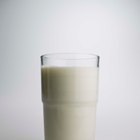Magone/iStock/GettyImages
Whipping cream or heavy cream contains between 36 and 40 percent fat. It occurs naturally in fresh milk and rises to the top due to the lighter weight of milk fats. In the industrialized world, cream - like other dairy products - must be pasteurized before it's sold. Dairies use either conventional pasteurization or ultra-pasteurization to make their whipping cream food safe. Both work, but there are practical differences between them.
Conventional Pasteurization
Pasteurization is the process of heating a food, usually a liquid, long enough to kill the majority of microorganisms that may be present. Time and temperature are interrelated, and the higher the temperature the less time is required for effective pasteurization. In conventional pasteurization, milk or cream is heated to 161 degrees Fahrenheit for 15 seconds to kill bacteria. For dairy products in general, this temperature provides an excellent compromise between flavor and food safety.
Ultra-Pasteurization
Ultra-pasteurization also kills microorganisms in the milk very effectively, but it takes a different approach to the process. In ultra-pasteurization, the milk is heated to a much higher temperature, typically 265 F to 280 F, but only for two seconds. Ultra-pasteurization makes it possible to process milk faster and more efficiently than traditional pasteurization and it also kills more microoranisms. This gives also gives the finished cream a longer shelf life, which - combined with the quicker processing - makes the process very cost-effective for dairies. In areas where cream is a slow seller, ultra-pasteurization can be the factor that makes it feasible for dairies and retailers to keep it on the shelves.
Effects of Ultra-Pasteurization
The downside to ultra-pasteurization is that subjecting the milk or cream to high temperatures breaks down the flavor of fresh dairy, giving it a discernibly "cooked" taste, and affects the whey proteins responsible for diary’s creamy texture. Some dairies compensate for this by adding thickeners such as carrageenan and guar gum to replicate the cream's original texture. The addition of congealing agents returns any lost creaminess, making ultra-pasteurized cream nearly identical to old-fashioned whipping cream in both flavor and texture. You will notice that ultra-pasteurized cream takes longer to whip than conventionally pasteurized cream, and it might not whip to quite the same volume, but the difference will be minimal.
Choosing and Using
You can use ultra-pasteurized cream in any recipe that calls for whipping cream. If you'll be using it as an ingredient in a sauce or baked good, there will be no detectable difference between the two. If you're whipping it for a dessert topping, conventionally pasteurized cream is your better choice because it has a cleaner taste and whips more easily. On the other hand, ultra-pasteurized cream's reluctance to form bubbles can be a virtue if you're making custard or chocolate ganache, where foaming is undesirable.
Related Articles

How to Substitute Cream for Buttermilk
Cream vs. Creamer

What Does Rennet Do in Ice Cream?

Why Does Some Alcohol Curdle Cream?

Why Does Cream Turn Into Butter?

Can You Make Chocolate Ganache Frosting ...

Heavy Cream vs. Milk in Baking

Can I Sub Condensed Milk for Cream in ...

Why Can't You Use Ultra Pasteurized ...

How Many Calories Are in Cream of Wheat?

Substitute for Light Cream in Cooking

How to Cook With Lactaid

What Happens if I Forget to Refrigerate ...

How to Fix Grainy Whipped Ganache

Heavy Whipping Cream Vs. Half & Half

How to Make Whipped Frosting Without ...

Differences Between Double Cream and ...

Different Types of Whipping Cream

Can You Make Homemade Mozzarella Cheese ...

How to Thicken Cream Filling
References
Writer Bio
Nannette Richford is an avid gardener, teacher and nature enthusiast with more than four years' experience in online writing. Richford holds a Bachelor of Science in secondary education from the University of Maine Orono and certifications in teaching 7-12 English, K-8 General Elementary and Birth to age 5.